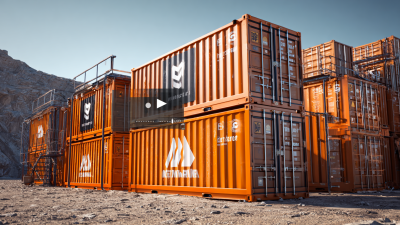How to Optimize Your Container Mining Strategy for Maximum Efficiency
In the rapidly evolving landscape of digital transformation, container mining has emerged as a pivotal strategy for organizations aiming to optimize their IT infrastructure and streamline operations. According to a recent report by Gartner, approximately 90% of companies will adopt containerization technologies by 2025, highlighting a growing recognition of its potential to enhance efficiency and reduce costs.

As businesses increasingly rely on microservices and cloud-native applications, optimizing container mining strategies becomes essential to harnessing the full benefits of this approach. This blog will delve into effective techniques and best practices that can drive maximum efficiency in your container mining operations, ensuring you stay ahead in a competitive environment where agility and performance are paramount.
Understanding the Basics of Container Mining: Key Concepts and Benefits
Container mining is an emerging strategy that leverages the benefits of virtualization and containerization to execute data-intensive tasks with improved resource efficiency. At its core, container mining allows organizations to run parallel computations across multiple containers, thereby optimizing resource utilization. A report by Gartner noted that organizations utilizing container orchestration can achieve up to 50% higher efficiency in their computational workloads compared to traditional virtual machine (VM) deployments.

Furthermore, the benefits of container mining extend to enhanced disaster recovery and improved security measures. By isolating applications in containers, organizations can mitigate potential risks and minimize downtime, ensuring that operations remain robust even under challenging conditions. As the industry trends towards increased adoption of containerized applications, understanding these fundamental concepts and their associated advantages becomes crucial for businesses aiming for maximum efficiency in their mining strategies.
Identifying Your Optimal Container Mining Configuration for Enhanced Performance
When it comes to container mining, achieving optimal performance hinges on a well-defined configuration tailored to your specific needs. Identifying the right balance of resources and deployment strategies can significantly enhance the efficiency of your mining operations. Begin by assessing workloads and determining the appropriate resource allocation, such as CPU and memory limits. This not only ensures that each container operates smoothly but also mitigates the risk of resource contention, which can hinder performance.
Incorporating effective monitoring tools is essential for maintaining oversight of container performance. By actively tracking resource usage and system health, you can identify bottlenecks and adjust configurations proactively. The latest tools available offer advanced features that allow for real-time analytics, alerting on performance issues, and detailed logging, which can be invaluable in tweaking configurations for optimal results. Adopting a data-driven approach to monitoring will provide insights that empower you to refine your container mining strategy continuously.

Implementing Best Practices for Resource Management in Container Mining
Implementing best practices for resource management in container mining is crucial for enhancing efficiency and sustaining profitability. One effective strategy is to optimize resource allocation by systematically monitoring and analyzing the usage of computational resources. Utilizing tools that provide real-time insights into resource consumption can help teams identify underutilized or overprovisioned containers. By adjusting resource limits based on actual needs, businesses can minimize waste and improve the overall performance of their container infrastructure.
Another essential aspect is the regular assessment of workflow processes. Streamlining operations through automation can significantly reduce manual errors and save time. Incorporating continuous integration and continuous deployment (CI/CD) practices allows for faster deployments and more reliable updates, ensuring that resources are used efficiently.
Furthermore, adopting a microservices architecture facilitates the independent scaling of different components, enabling better resource management tailored to specific workloads. By focusing on these best practices, organizations can create a more robust and efficient container mining strategy that maximizes resource utilization and minimizes operational costs.
Leveraging Automation and Tools to Streamline Your Mining Processes
In today’s rapidly evolving container mining landscape, leveraging automation and advanced tools is vital for optimizing efficiency. According to a report by Gartner, organizations that adopt automation technologies have seen a 25% reduction in operational costs and a 30% improvement in workflow efficiency. This is particularly relevant in container mining, where the complexity of environments can sink productivity if not managed effectively. By integrating automated deployment tools, companies can streamline repetitive tasks, minimize human error, and allocate resources more strategically.
Furthermore, utilizing modern monitoring tools can aid in real-time analysis, enhancing decision-making processes. A study by McKinsey found that companies employing sophisticated analytics in their mining operations report a 15-20% increase in yield. By integrating these analytical tools, businesses gain insights into resource allocation, equipment performance, and potential bottlenecks. This allows them to make data-driven adjustments swiftly, ensuring their mining strategies remain aligned with market demands while maximizing overall efficiency. Investing in these technologies not only improves operations but also positions organizations to respond more adeptly to future challenges in the ever-competitive container mining sector.
Mining Efficiency Optimization
This chart illustrates the efficiency of container mining processes at various levels of automation. As automation increases, the efficiency significantly improves, reaching up to 95% with full automation.
Monitoring and Analyzing Performance Metrics for Continuous Improvement
To effectively optimize your container mining strategy, it's essential to focus on monitoring and analyzing performance metrics. By establishing key performance indicators (KPIs) tailored to your mining operations, you can gain valuable insights into the efficiency of your processes. Metrics such as container utilization rates, processing times, and energy consumption should be regularly tracked to pinpoint areas for improvement. Implementing robust monitoring tools will facilitate real-time data collection, allowing you to respond swiftly to performance fluctuations.
Continuous improvement hinges on the analysis of this performance data. By examining trends over time, you can assess the effectiveness of changes made within your strategy. For instance, if you notice a consistent decline in output, it may indicate the need for technological upgrades or workforce training. Additionally, leveraging data analytics can help in predicting potential bottlenecks and optimizing resource allocation. This proactive approach not only enhances efficiency but also drives long-term success in your container mining operations.
Related Posts
-

What Makes Container Mining a Game Changer in the Industry
-

7 Proven Reasons to Invest in Container Bitcoin Mining for Your Business Success
-

Future Technologies Shaping Crypto Mining Container Strategies for 2025
-

Unveiling the Technical Specifications of Top Notch Asic Mining Equipment at the Best Asic Mining Shop
-

Unmatched Quality of Best Mining Containers From China Meeting Global Industry Standards
-

7 Essential Tips for Selecting the Best Bitcoin Mining Container Manufacturer Worldwide
